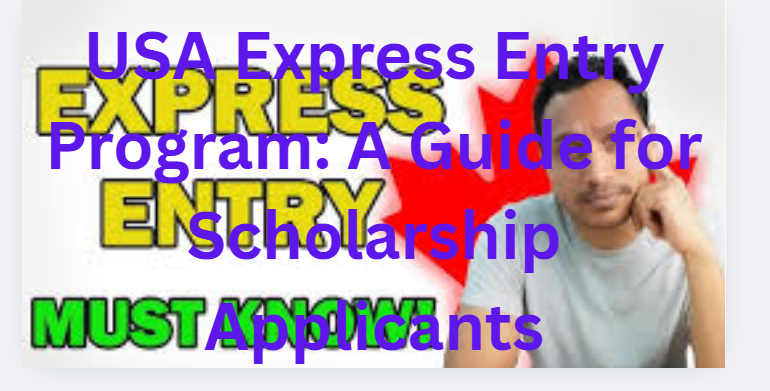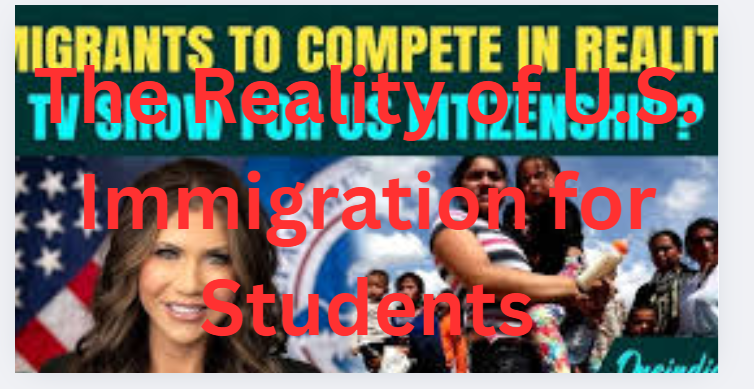
If you’re researching how to move to the United States for your studies and a future career, you might have come across the term “Express Entry.” It’s important to start with a clear understanding: there is no official U.S. immigration program called “Express Entry.” This name belongs to Canada’s fast-track system for skilled workers.
This mix-up is very common, and it points to a real desire for a simple, direct path. The good news is that while the name is incorrect for the U.S., the goal of combining a scholarship with a clear immigration pathway is still achievable. This guide will clarify the real U.S. process and show you, as a scholarship applicant, how to navigate it effectively.
The Reality of U.S. Immigration for Students

The United States does not have a points-based “express” system. Instead, it uses a multi-step process that often begins with education. For a scholarship applicant, the journey typically looks like this: you use your scholarship to study in the U.S., then you use your U.S. degree to secure work authorization, and finally, you transition from a temporary work visa to permanent residency (a Green Card).
Think of your scholarship as the key that unlocks the first and most important door: a quality U.S. education. This education is what will make you a strong candidate for U.S. employers down the line.
Why This Path is Powerful for Scholarship Winners
Winning a scholarship to study in the U.S. provides a solid foundation for several reasons:
- Credibility: A U.S. degree from a recognized institution is highly valued by American employers.
- Practical Experience: After graduation, you are eligible for Optional Practical Training (OPT), which allows you to work in your field for 12 months, or 36 months if you graduate from a STEM (Science, Technology, Engineering, and Math) program.
- Networking: You will build a professional network that can lead to crucial job opportunities, which are necessary for the next immigration steps.
Your First Step: The F-1 Student Visa
Once you have your acceptance letter and scholarship offer from a SEVP-certified school, you will receive a Form I-20. This document is essential for applying for your F-1 student visa.
During your visa interview, your scholarship is a significant advantage. It demonstrates to the consular officer that you are a serious student with substantial financial support, which addresses a key requirement.
A critical point to remember: when applying for your F-1 visa, you must convince the officer that you have ties to your home country and intend to return there after your studies. Your long-term hopes for immigration should not be the focus of this conversation. The immediate goal is to secure permission to study.
The Bridge from Student to Professional: OPT
After you complete your degree, your F-1 visa status allows you to apply for Optional Practical Training (OPT). This is a period of temporary employment directly related to your major area of study.
OPT is your first official opportunity to gain U.S. work experience. It acts as a critical bridge, allowing you to work for any employer in your field without needing a separate work visa sponsorship yet. For many, success during OPT is what leads an employer to decide to sponsor them for a long-term visa.
The H-1B Visa: The Common Next Step
The most common visa that international students transition to after OPT is the H-1B. This is a visa for specialty occupations that typically require a bachelor’s degree or higher.
However, the H-1B presents the biggest hurdle in the U.S. immigration process: the annual lottery. There is a high demand for a limited number of visas, and selection is random. If you are not chosen in the lottery, your ability to remain in the U.S. after your OPT ends becomes uncertain.
This is where the term “Express Entry” creates a misleading expectation. The Canadian system is predictable based on points; the U.S. H-1B process involves significant chance.
How Your U.S. Degree Helps
While the lottery is a gamble, your U.S. education is what makes you eligible to play. It qualifies you for a “specialty occupation” and makes you a more attractive candidate to employers who are willing to go through the sponsorship process.
Beyond the H-1B: Other Pathways to Explore
Relying solely on the H-1B lottery can be stressful. It’s wise to be aware of other options. For high-achievers, there are pathways that don’t depend on an employer-sponsored lottery.
- O-1 Visa: Individuals with Extraordinary Ability
This visa is for people who have demonstrated sustained national or international acclaim in fields such as sciences, arts, education, business, or athletics. A strong record of scholarships, publications, and academic awards can contribute to an O-1 application. - EB-2 National Interest Waiver (NIW)
This is a path to a Green Card itself. It allows professionals with an advanced degree or exceptional ability to “self-petition” if they can prove their work is in the vital interest of the United States. A master’s or PhD earned in the U.S., along with a promising research focus, can be a strong foundation for an NIW.
These options are complex and have high standards, but they are important to know about, especially for scholarship recipients who are often top performers in their fields.
Important Considerations for Your Journey
- Plan for the Long Term: The process from student to permanent resident can take many years. It requires patience and resilience.
- Maintain Your Status: Always ensure you comply with the rules of your visa, whether F-1 or H-1B. Falling “out of status” can seriously jeopardize your future in the U.S.
- Seek Expert Advice: U.S. immigration law is complex. It is highly recommended to consult with your university’s International Student Office and, later, an experienced immigration attorney.
Conclusion: Your Path, Redefined
While the “USA Express Entry Program” doesn’t exist, your dream of building a life in the U.S. through your education is very real. The path is simply different from Canada’s—less of an expressway and more of a strategic journey with several key checkpoints.
Your focus should remain on what you can control: excelling academically to win a great scholarship, making the most of your OPT period to gain valuable experience, and building a strong professional profile. By understanding the real system, you can move forward with clarity, purpose, and a much stronger chance of long-term success.
Frequently Asked Questions (FAQs)
Is there really a U.S. Express Entry program?
No, this is a common misconception. “Express Entry” is specifically Canada’s immigration system. The U.S. does not have a program by this name. The path to immigration in the U.S. is typically more complex and involves multiple steps, often starting with a student or work visa.
How can a scholarship help me immigrate to the U.S.?
A scholarship itself doesn’t lead directly to immigration, but it is a powerful first step. It enables you to obtain a U.S. degree, which makes you a more attractive candidate to U.S. employers. These employers may then sponsor you for a work visa, which can eventually lead to permanent residency (a Green Card). The scholarship essentially funds the foundational part of your journey.
What is the easiest way to stay in the U.S. after my studies?
The most common path is to apply for Optional Practical Training (OPT) after graduation. This allows you to work for 1-3 years. During this time, you need to find an employer willing to sponsor you for an H-1B work visa. However, the H-1B is subject to an annual lottery, so there is no guarantee. It’s the standard path, but not necessarily “easy.”
What happens if I don’t get selected in the H-1B lottery?
This is a significant challenge. If your OPT ends and you are not selected in the H-1B lottery, your options become limited. Some people apply for another degree program to maintain student status, explore other visa types (like the O-1 for extraordinary ability), or may have to leave the U.S. It’s crucial to have a backup plan.
Are there ways to get a Green Card without an employer?
Yes, but they are less common and have high requirements. The EB-2 National Interest Waiver (NIW) allows individuals with advanced degrees or exceptional ability to self-petition for a Green Card if their work benefits the U.S. The EB-1A visa is for those with extraordinary achievements. These paths are complex but do not require employer sponsorship.